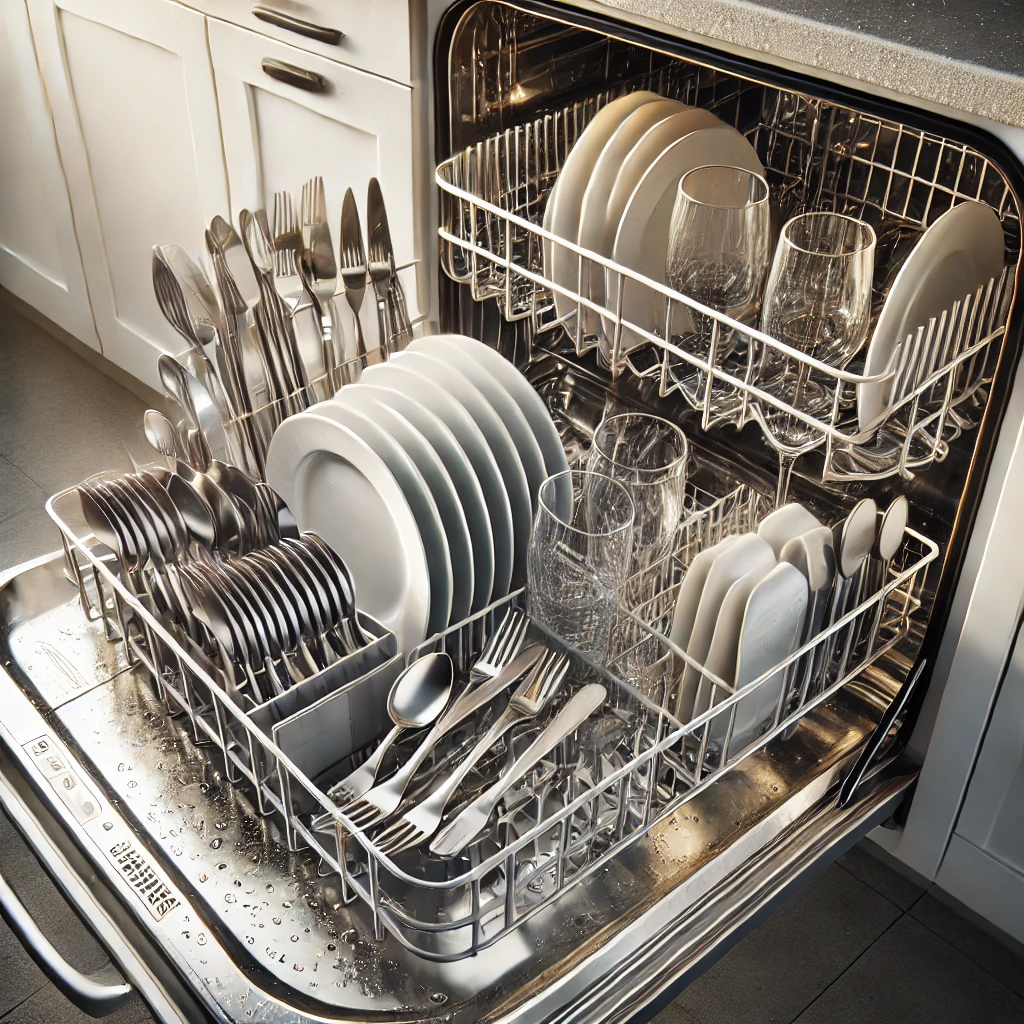
Dishwasher Preventative Maintenance Tips
Your dishwasher is a convenient appliance that saves you time and effort in the kitchen, but like any machine, it needs regular care to keep it functioning properly. With a few simple preventative maintenance tips, you can extend the lifespan of your dishwasher and avoid costly repairs. Here’s how to maintain your dishwasher for long-lasting performance.
1. Clean the Filter Regularly
The filter in your dishwasher is responsible for trapping food particles, preventing them from clogging the drain. Over time, the filter can become clogged with food debris, which can lead to poor cleaning performance and unpleasant odours.
How to Clean the Filter:
- Locate the Filter: The filter is usually located at the bottom of the dishwasher, near the spray arm. Check your dishwasher’s manual for specifics.
- Remove the Filter: Turn and lift the filter to remove it from the dishwasher.
- Clean the Filter: Rinse the filter under warm running water, using a soft brush to scrub away any food particles or grease. If necessary, soak it in warm, soapy water for a few minutes before scrubbing.
- Reinstall the Filter: Once clean, place the filter back in its original position and secure it.
How Often to Clean: Clean the filter every 1-2 weeks, depending on how often you use the dishwasher.
2. Check and Clean the Spray Arms
The spray arms are crucial for distributing water throughout the dishwasher during the cleaning cycle. If the spray arm holes become clogged with food particles or mineral deposits, your dishes may not be cleaned properly.
How to Clean the Spray Arms:
- Remove the Spray Arms: Some models allow you to remove the spray arms for easy cleaning. Refer to your dishwasher’s manual to learn how to detach them.
- Clean the Holes: Use a toothpick or small brush to clear any food debris or mineral build-up from the holes in the spray arms.
- Rinse and Reinstall: Rinse the spray arms under warm water, then reinstall them in the dishwasher.
How Often to Clean: Clean the spray arms every few months to ensure proper water flow.
3. Run a Dishwasher Cleaning Cycle
Just like other appliances, dishwashers can accumulate grease, food particles, and soap scum over time. Running a cleaning cycle helps eliminate build-up and keeps your dishwasher smelling fresh.
How to Run a Cleaning Cycle:
- Empty the Dishwasher: Make sure the dishwasher is empty of all dishes.
- Use Dishwasher Cleaner: You can use a store-bought dishwasher cleaner or a natural alternative like white vinegar or baking soda. Place a dishwasher-safe bowl filled with vinegar on the top rack or sprinkle a cup of baking soda on the bottom of the dishwasher.
- Run a Hot Water Cycle: Set the dishwasher to run on the hottest cycle. This will break down grease and mineral deposits while disinfecting the interior.
How Often to Clean: Run a cleaning cycle every month to maintain cleanliness and efficiency.
4. Inspect and Clean the Door Seals
The door seals (gaskets) prevent water from leaking out of the dishwasher during a cycle. Over time, food particles and grime can accumulate on the seals, causing them to wear down and lose their effectiveness.
How to Clean the Door Seals:
- Wipe the Seals: Use a damp cloth or sponge with warm, soapy water to gently wipe around the door seals and the edges of the door.
- Check for Damage: Inspect the seals for any signs of wear, cracking, or mould. If you notice significant damage, you may need to replace the seal.
How Often to Clean: Clean the door seals every month to prevent grime build-up and maintain a good seal.
5. Check and Clean the Drain
The dishwasher’s drain is responsible for removing dirty water during the wash cycle. If the drain becomes clogged, it can lead to slow drainage or standing water at the bottom of the machine.
How to Clean the Drain:
- Inspect the Drain: After each cycle, check the area around the drain for any food debris or clogs.
- Clear the Drain: If you notice any blockages, remove them with a paper towel or a small brush.
- Run a Cleaning Cycle: Running a cleaning cycle with vinegar or baking soda can also help break down any residue or build-up in the drain.
How Often to Check: Check the drain every month and clean it as needed to prevent clogs.
6. Don’t Overload the Dishwasher
Overloading the dishwasher can prevent proper water circulation, which means your dishes won’t get cleaned effectively. It can also place unnecessary strain on the dishwasher’s components, leading to wear and tear over time.
How to Avoid Overloading:
- Leave Space Between Dishes: Make sure there’s enough space between each dish to allow water and detergent to reach all surfaces.
- Use the Right Rack for the Right Items: Place larger items like pots and pans on the bottom rack and lighter items like glasses and small bowls on the top rack.
Tip: Don’t cover the spray arms with oversized dishes, as this can block water from reaching other items.
7. Use the Right Detergent
Using the correct detergent is crucial for your dishwasher’s performance. Avoid using regular dish soap, which can create excess suds and lead to malfunctions.
Detergent Tips:
- Use High-Quality Detergent: Choose a detergent that is specifically designed for dishwashers, whether it’s powder, gel, or pods.
- Avoid Overusing Detergent: Follow the manufacturer’s recommendations for the correct amount of detergent. Using too much can lead to detergent build-up and leave streaks on your dishes.
- Use a Rinse Aid: Consider adding a rinse aid to improve drying performance and prevent water spots.
8. Inspect the Hoses for Leaks
Dishwasher hoses, which carry water to and from the appliance, can wear out over time. Regularly inspecting the hoses for leaks or cracks can prevent water damage to your kitchen.
How to Inspect the Hoses:
- Check for Leaks: Look for any visible signs of leaks, cracks, or wear on the hoses. Pay special attention to the connections where the hoses attach to the dishwasher and the water supply.
- Tighten Connections: Ensure all hose connections are tight and secure. If a hose is worn out or damaged, it should be replaced.
How Often to Check: Inspect the hoses every six months or whenever you notice a leak.
Conclusion
By following these simple preventative maintenance tips, you can keep your dishwasher running efficiently for years to come. Regularly cleaning the filter, spray arms, and drain, as well as checking the hoses and door seals, will prevent common issues and extend the lifespan of your appliance. With a little regular care, your dishwasher will continue to make your life easier without the worry of breakdowns or costly repairs.

